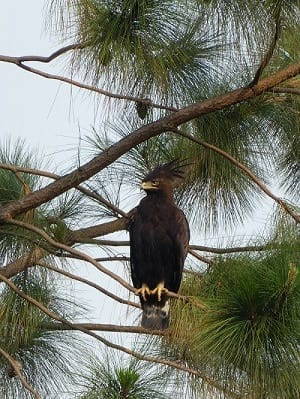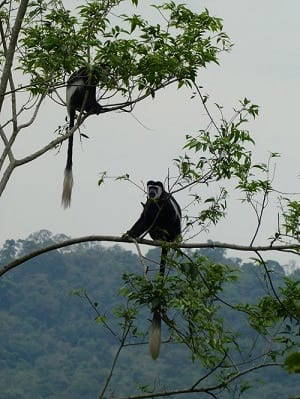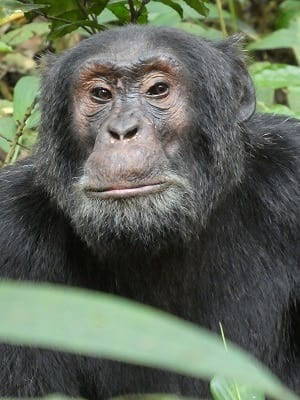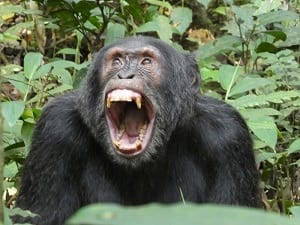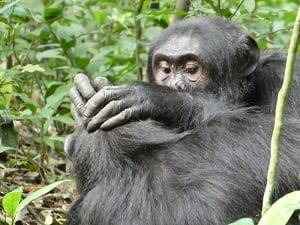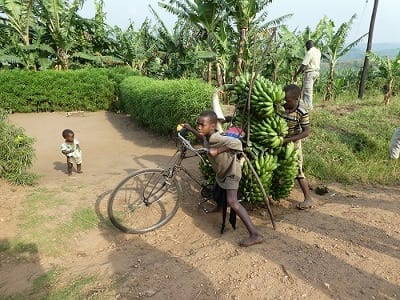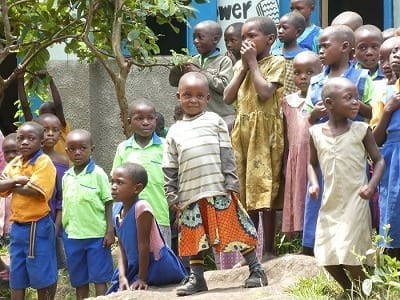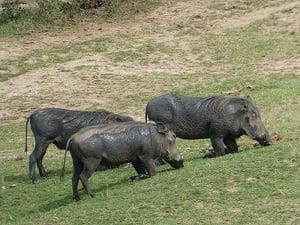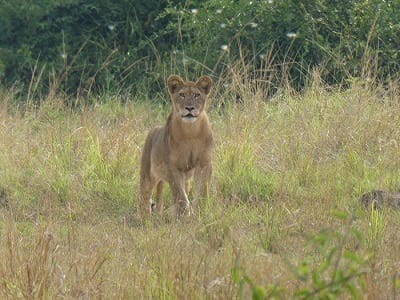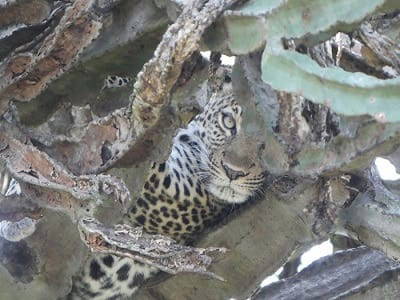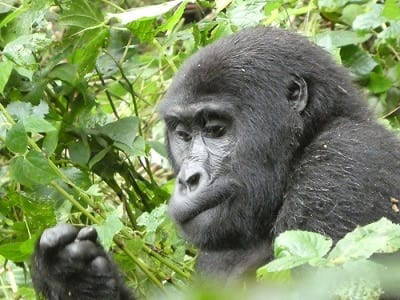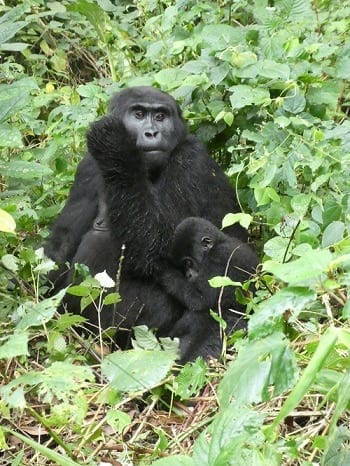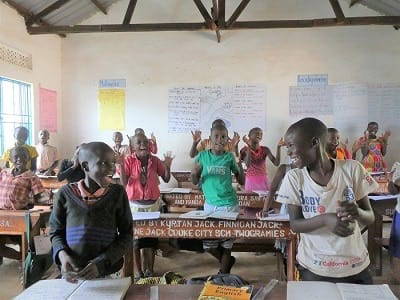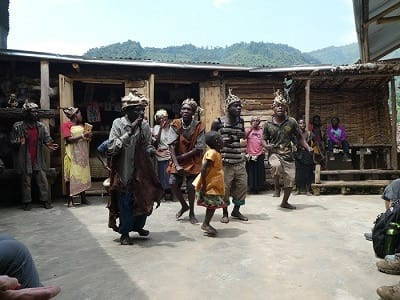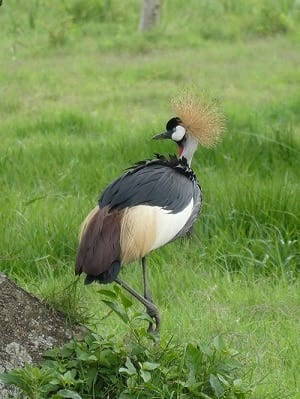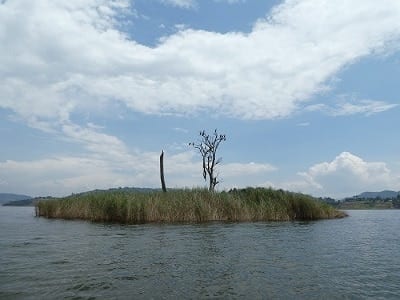In February, Camilla was lucky enough to be amongst the final few visitors to enter Bwindi National Park and pay homage to its local population of mountain gorillas before the coronavirus outbreak caused the suspension of worldwide travel. She also fell in love with Uganda and regards this – her first trip to Africa – as one of her best travel experiences yet.
My Emirates flights via Dubai ran to schedule and I arrived in Entebbe in the afternoon excited for what lay ahead. I was greeted just outside the airport and was soon being whizzed towards Kampala with the van window wide open, the welcome breeze rushing in, along with the sights and sounds of suburban Uganda.
Surrounded by views across Lake Victoria and the outskirts of the city I met the group for dinner on the hotel terrace and we were briefed on what to expect from the days ahead.
The journey to Kibale rainforest was long, our group of 12 was split between 2 pop-top vans, driven by our group leader Robert and our “fixer” Umar. It was an early start in an attempt to beat the traffic as we drove through Kampala.
One street we took was entirely dedicated to furniture sales, with beds, chairs and sofas stacked up along the busy road side. We all knew when we were passing the fish market, not only from the smell, but also the swarms of Marabou storks perching or circling overhead to scavenge scraps.
Heading out of Kampala the traffic quietened and I started to become accustomed to the dusty roads interspersed with more speed bumps than seemed necessary! We stopped off at one of the many fruit stands along the roadside to try some produce, the abundance of colourful fresh fruits and vegetables were stacked uniformly in small piles some more familiar than others. We drove through tea plantations and stopped for lunch at a restaurant en route. Opting for the buffet I got to try yams, cassava and mashed plantain accompanied by flavoursome beans and a delicious creamy nut sauce.
I had not realised what a great destination Uganda is for bird spotting, with well over 1000 species. We started to spot some of the more recognisable ones on our journey into the National Park such as the long-crested eagle, woodland king fisher and cinnamon crested bee-eater.
We also got our first peak of some primates as we continued further into the jungle. The cheeky baboons lined the roads hoping for scraps from tourists and timid black and white colobus monkeys peaked out at us from the safety of the trees.
When we arrived at Primate Lodge, the only accommodation within the National Park, I was greeted with a familiar scent of tropical fauna, reminiscent of the greenhouses in the botanical gardens I had visited as a child. Walking around the grounds I was lucky enough to spot a fire-footed rope squirrel and a black-and-white-casqued hornbill as well as some red-tailed monkeys swinging overhead.
A group of dancers performed their lively song and dance routine to welcome our arrival before we sat for the first of many delicious 3 course dinners.
The next day we were off to track wild chimpanzees. We were split into two groups of 6 and assigned a tracker, ours being a young woman called Anette. We had been walking no more than 10 minutes when two known local male chimpanzees named Bahoire and Kosa calmly approached us on an open path. They walked right by us and into the thicker undergrowth. Anette was almost as shocked as we were! We began to follow Kosa, a 35-year-old male.
He was in pursuit of a 32-year-old female named Kabubu, who was on heat. We observed their game of cat and mouse; Kabubu would move on through the jungle and Kosa would follow at a distance, as would we. They stopped several times, giving us ample opportunity to observe them closely on the ground. Females are generally shy and keep their distance, but Kosa was not perturbed by our presence and would stare straight back at me and my camera without a care.
After moving on and stopping 2 or 3 times the pair stayed settled for a while. It seemed that Kosa was either building up the courage to make his move, or was not so interested after all. Just then another female approached the couple, she was also on heat and far less reserved than Kabubu. Kosa mated with the new arrival setting Kabubu off in a frenzy of disgruntled shrieking and who could blame her?
She stayed within arm’s reach of the pair, who put on an elaborate display of meticulous grooming. I knew I was experiencing something out of the ordinary when Anette kept saying “wow” at their behaviour. She told us what we had experienced was very rare, to see them on the ground for such a long time was very unusual and to see them mating was almost unheard of.
Buzzing from the experience we made our way back to the road and walked towards phone signal to contact our pick up, when 3 more chimps crossed the road ahead of us. We couldn’t believe our luck.
In the afternoon we went for a swamp walk around some nearby wetlands and saw an abundance of monkeys including grey cheeked mangabey, black and white colobus, red colobus, black faced vervet and baboons as well as some impressive birds such as the blue turnaco.
Another early start had us back on the road at 7:30am the next day to begin our journey to Queen Elizabeth National Park. Robert took us along his “short cut” route through villages full of locals going about their daily lives. The children, always excited to see our vehicles go past, would run towards us waving and shouting “mzungu”, meaning white person. The more reserved among them couldn’t resist waving if you flashed them a smile, their happy faces were unforgettable. The average age in Uganda is 14 years old, which sounds almost unbelievable, until you see how many children there are everywhere, then it makes a lot of sense!
As our journey continued, we drove past Lake Bunyonyi, which appears on the 10000-shilling note and through tea plantations, noticing the temperature reduce.
Bananas are a staple food crop in Uganda and they are bought and sold at market. Transporting bananas is no easy feat when your only means of transport is a bicycle, which is the case for many families with a small crop. It is a common sight to see a bike laden beyond comprehension with this awkward, heavy fruit. We stopped to meet 2 young boys age 10 and 16 who were loading up their bicycle to get their precious bananas to market. The bike was so overloaded they could barely keep it from toppling over. I felt overwhelmed with emotion watching their struggle. A thoughtful member of our group had bought toys to give to children as we travelled around and when he received a frisbee from her his face lit up. Considering all their bananas would only fetch USD6 this small gesture made a big difference.
We now crossed into a new realm, where we saw a change in landscape and temperature. We had arrived in the foothills the Rwenzori Mountains, at the source of the Nile River, also known as ‘The Mountains of the Moon’. As we drove through the mining settlement the destruction of the 2013 flood still dominated the village, whole homes had been picked up and dumped by the roadside. We took a mellow walk along the boulder filled riverbed towards the base of Stanley, Uganda’s highest mountain, third highest in Africa behind Kilimanjaro and Mount Kenya.
We arrived at a primary school, where the cheeky children seemed to be bursting out of every doorway and window in anticipation of your visit. We were delighted to be treated to music and entertainment from the children’s dance team, there were even some songs I recognised from many years ago!
After lunch we completed our journey to Elephant Planes Lodge on the outskirts of Queen Elizabeth National Park, offering views over Lakes Edward and George as well as the crater Lake Katwe. With time to myself I couldn’t resist a dip in the pool accompanied by my new favourite Nile Special Beer and salty popcorn.
Before daylight we picked our spots in the pop-top vans for our first game drive. As we waited at the entrance to the park we watched weaver birds popping in and out of their pendulous nests clinging to a nearby acacia tree.
Driving down the rough track our first sighting was of a lone hyena, galumphing through the grass and shrubs. We drove along tracks spotting cape buffalo, waterbuck and warthogs.
Things got exciting when Robert sped up, with an air of anticipation. Careful not to let us in on his tip-off we came to a stop and stood watching the grass ahead. In the near distance we could see a lioness climbing down from a candelabra tree, followed by another and then another. The trio didn’t adjust their path, they walked right up to our vehicles and paid us little notice as they continued on past.
The lead lioness had a noticeable gash across her left shoulder and quite a collection of old battle-scars.
Robert decided we should try to catch up with them again and took off along a track hoping to intercept them. We stopped at a spot he thought most likely to cross their path and lo and behold two of them appeared again from the tall grass and climbed a nearby tree, the third had stayed behind relaxing in a candelabra tree back along the way, just in sight.
After another tip-off we drove to a very specific tree and began to slowly circle it. My eyes were feverishly searching the tree for whatever wildlife was camouflaged within. Then I saw her, a female leopard, clumsily lazing in the spiky branches. Her stunning features peaked out from behind a branch to get a glimpse of us looking at her.
Following another epic lunch, we were off on a boat trip along the Kazinga Channel where Lake George drains to the southwest into Lake Edward. We had spotted the odd elephant and hippo up to this point, but here they lived along the banks of the channel in abundance. The birdlife was teaming and as we floated along, we spotted many species including the pied kingfisher and African fish eagle.
Crocodiles basked on the shores and sloped off into the channel becoming almost invisible to any unsuspecting prey. On our way back we were lucky enough to see two very rare giant forest hogs as they disappeared into the undergrowth.
Today we would make the journey from the savannah to jungle on our way to Bwindi in search of the mountain gorillas. Robert had warned us that we would be doing the “African dance” on the road today. The roads through the Ishasha sector of the National Park were dirt tracks carved out with huge ruts, the way Robert and Umar manoeuvred the vehicles was an impressive feat.
This area is best known for its tree climbing lions. All lions climb trees, but some are better than others, I guess! We were not lucky enough to see a lion today, there had not been a sighting for a few days. We did see many more birds, primates, an elephant and hundreds of butterflies.
Continuing our journey through luscious countryside and small settlements we eventually arrived with a bump at the lodge in Bwindi. Enjoying views across the impenetrable jungle as far as the eye could see I could feel the anticipation for tomorrow starting to build.
Finally it was here, the long-awaited day I would see mountain gorillas! We went for a morning briefing and were split into groups depending on hiking ability. There were only 6 in my group and we were allocated to the Mubare family group, which were the first family to be habituated in Uganda. We were encouraged to hire a porter as there are so many local people who rely on this as their main source of income, even though each porter may only work 1 or 2 days a month. The rest of the time they mostly farm various crops. My porter was called Benison, he was 25 and married with a 2-year-old daughter, a coffee farmer by trade and a very attentive porter.
We were dropped off on a dirt track which lead up through some smallholdings to the edge of the forest. Entering the jungle, we followed our tracker blindly as he hacked his way through the undergrowth. Suddenly we were all covered in black ants, which bite and hold on for dear life. Annoying in any situation, but for me hugely concerning, possibly life threatening as in Sri Lanka a couple of years ago, I was hospitalised by the little blighters! Luckily the antihistamines seemed to keep me from going into shock and we continued on.
After an hour and a half we met with the other trackers, who had been busy searching for our gorillas since the early hours. THEY WERE CLOSE. As they hacked through the vegetation with machetes I followed closely in anticipation.
I got my first glimpse of the silverback, known by Mariah, meaning fond of women, through the leaves. At 28 years old he is considered to be middle aged for a gorilla.
I was encouraged to pass through an opening that had been cut, getting very close to Mariah, his grunts and heavy breaths were intimidating. I momentarily gained eye contact, which I could feel in the pit of my stomach. He moved on towards a more open area and settled to feed.
Mesmerised momentarily, the trackers ushered me to a lower spot where I could peak through the bushes to see a mother and her tiny baby. Then behind me another mother and baby appeared from the undergrowth. The young were 1 and 2 months old. As gorillas only reproduce every 4 years, we were incredibly lucky to see two that were so tiny.
The family were feeding and every now and then moved on to a different spot. We followed them as best we could through thicker trees and undergrowth, sliced away by the trackers to let us through. As the gorillas were not stationary we stayed with them for more than an hour watching them feeding, moving around and tending to their little ones. A female, with her baby clinging on tight, chose a path through where we were standing and we quickly moved out of her way. At the place where we left them there were three females, two with their young and the silverback in close proximity. I was reluctant to leave, the time had flown by and I could hardly tear myself away.
We found an ant-free spot to have our packed lunches and eventually made our way back to the lodge. The rest of the day was spent reliving the experience with the group and feeling incredibly lucky indeed.
Surrounded by the ‘impenetrable jungle’ for another day we had the opportunity to visit the local community. We were taken into the heart of the village, where tea, coffee and bananas are staple crops. The dwellings reminded me of a medieval village. We were introduced to Henry, a local character who first showed us the lengthy process he undertakes to make banana gin. After the demonstration we were treated to a sample! Feeling a little sozzled, Henry then demonstrated the coffee process from plant to cup and we were re-invigorated by his personal brew.
Next, we were taken to Bwindi Nursery and Junior Plus School. Entering the classrooms, the children were excited to have visitors and at the mention of entertainment they fled the confines of the room and lead us to an open area where they wowed us with their singing, dance and drumming skills.
Then it was on to the Pigmy village. We were greeted by the chief, followed by demonstrations of hunting, trapping and fire building. I was invited by the chief to his treehouse, making me the honorary queen of the village for the day, my chief was 87!
Finally, we paid a visit to a women’s refuge called Ride for a Woman. The grounds were serene and a comfortable environment has been created for these inspirational women who have sought protection from domestic violence. They have been taught to sew and weave and create the most beautiful articles and practical objects from colourful batique fabrics.
In the afternoon a few of us visited an orphanage which had been set up in 2015. There are three kinds of orphan living here, those who have lost both parents, those who have lost a father, but their mothers new husband refuses to raise another man’s children and those whose parents are simply too poor to care for them. Some of the children were not present as they live in foster homes within the community. The children dragged us up to join in as they welcomed us by song. Then preformed traditional dances for marriage, education and circumcision! This was the most emotive and impressive performance yet, not to mention the loudest. These talented children are encouraged to draw pictures to sell to tourists to raise some personal pocket money. At a mere mention of this the ground was covered with their drawings, mostly of gorillas. I was so impressed by their talents, it was tough to choose, I wanted to buy them all.
I felt emotional leaving Bwindi, not only had I come face to face with mountain gorillas here, but with some truly amazing people, all experiences that will stay with me for a lifetime.
The road was winding and we were still in the thick of the jungle. We spotted some new primates along the roadside, blue monkeys and l’hoest’s guenon monkeys as well as plenty of birdlife in the canopy. As we drove out of the National Park we were greeted with spectacular views across rolling hills and open farmland, the dense treeline marking the border of the park. As we neared Lake Bunyonyi, the second deepest lake in Africa, we saw Uganda’s national bird, the grey crowned crane.
We had a picnic by the shore and watched the black headed weaver birds pop back and forth between their nests in the reeds. This enormous lake is scattered with islands, some with stories to tell. We hopped on an open boat to see a few from the water. The owner of one island has imported a collection of kobs, zebras, impalas and donkeys for tourism, a bizarre combination! Another island, previously used to house and treat lepers is now home to a primary and secondary school, a church and a hospital. The hospital is mainly for maternity needs and women in labour are collected by boat and looked after for three to four days, before they are left to make their own way home with their baby. There is also a particularly small and secluded island, where women who fell pregnant before marriage used to be stranded to starve to death.
Occasionally they may be saved by a fisherman too poor to offer a dowry to a perspective wife’s family. This is no longer the local practice thankfully.
Tonight’s accommodation, high on the hillside offered stunning views across the lake and its islands, on a clear day a volcano is visible on the other side. We were treated to a thunderstorm later in the evening and I actually needed a jumper!
Another early start took us on a road through small towns and settlements. We stopped at a petrol station and one of the vehicles needed some work, so to kill some time we walked down the road to the banana market to take a closer look. It seemed like mayhem, bananas arriving on overloaded bikes and motorbikes, labelled and sold then shipped out on metal framed trucks. Turning around to head back a crowd of men had gathered behind us, I realised I had become the attraction and they grabbed me to pose for friendly selfies!
Soon we were back on the road to Lake Mburo National Park. We had lunch at our accommodation before setting off on a game drive. We got to see wild dwarf mongoose, common zebra and impala before alighting the vehicles and continuing on foot to get closer to a group of Rothschild giraffes a little distance from the road.
Our final meal as a group was also a birthday celebration, a happy distraction from the sad fact that the trip was at an end. The journey to the airport was long and solemn as I prepared to leave this amazing country. Our only stop was at the equator, where we watched an enthusiastic opportunist demonstrate the behaviour of water down a plug hole in the northern and southern hemisphere compared with smack bang on the equator. All too soon I was back at Entebbe ahead of my overnight flight home.
I wish to thank Pip and Ciaran at ‘Explore’ for their help in enabling me to join this group tour. If you would like to discuss travel in Uganda then please get in touch. Mountain gorillas can also be seen in neighbouring Rwanda – ask my colleague Rob about travel there too if you wish to compare what the two countries have to offer.


